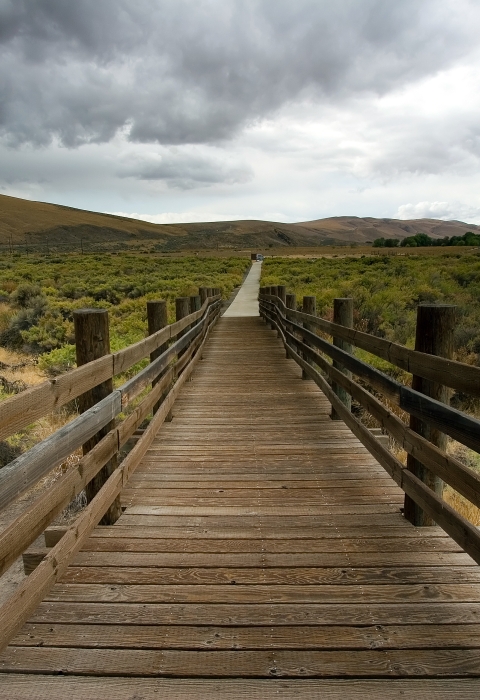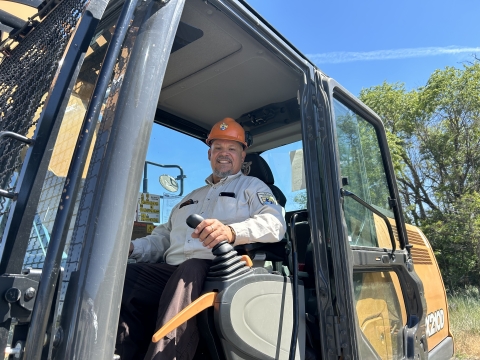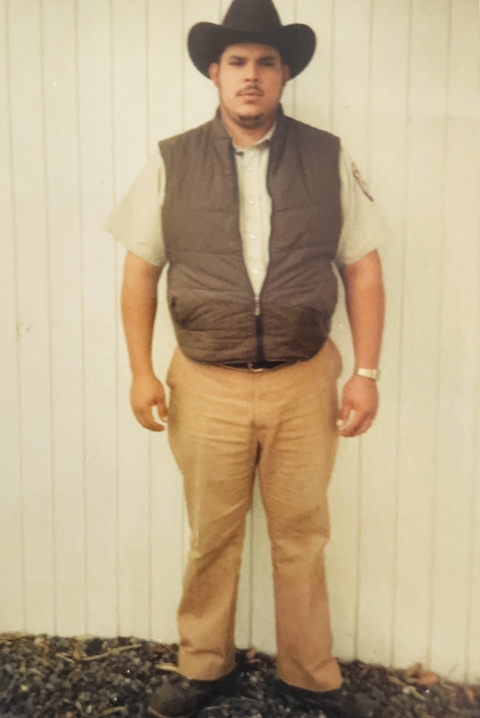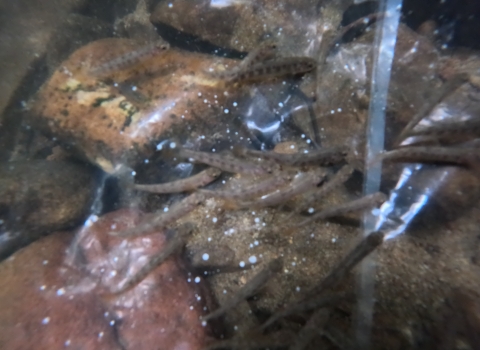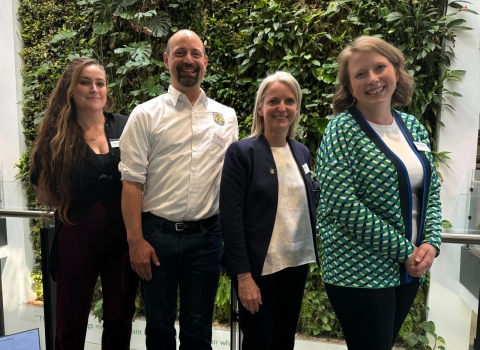Robert Luna knows Toppenish National Wildlife Refuge better than anyone else.
As an engineering equipment operator for more than 33 years, Luna has dedicated his life to maintaining the refuge and improving its habitat for plants and animals. In recognition of his innovation, passion, and diligence, Luna was named the National Wildlife Refuge Association’s Refuge Employee of the Year.
"Robert has been the heart and soul of Toppenish National Wildlife Refuge for more than three decades, and his contributions are beyond measure,” said Trevor Sheffels, the acting deputy project leader for the Central Washington National Wildlife Refuge Complex. “He is always focused on advancing the refuge mission, which is evident through the dedication he exhibits daily and his willingness to go above and beyond. Robert is also quick to offer to help others, both professionally and personally. He is a well-respected member of the local community, and the refuge system could not ask for a better ambassador. It is an honor to work with Robert and learn from his vast experience."
Despite his accomplishments, Luna was surprised to hear that he received an award.
“I never do anything for praise,” Luna said. “I let my work speak for itself. I’m proud of what I do and I’m always happy to show anybody the kind of work I do. I see the vision of the Fish and Wildlife Service, and you know, I enjoy it.”
At national wildlife refuges across the country, passionate people like Luna are working to ensure present and future generations will be able to enjoy the wildlife and wild places that define America. Established to protect wildlife, plants, and the places they depend on to live and grow, refuges protect almost a billion acres of public land and water – from the Mariana Trench in the Pacific Ocean and to wetlands in Toppenish, Washington.
Luna started working at Toppenish as a teenager when he joined a Youth Conservation Corps work program. He’s stayed with Toppenish for almost all his career. Engineering equipment operators are key members of a refuge’s management team, restoring habitat, maintaining water structures, creating roads and trails, and more.
“I wanted to learn about equipment operations, and the refuge had an opportunity for me to look at what they did,” Luna said. “I was able to come out here as a youth to learn new skills and get some job training.”
Luna was born in Los Angeles, California, and he and his family moved to Toppenish in the 1980s. He was still a child when they moved, and the small town was a totally new experience. Before joining the Youth Conservation Corps, he didn’t know the refuge existed.
“It was a new adventure for us to move from the big city to the country,” Luna said. “I didn’t know about wetlands or anything. When I was introduced to the refuge, I wanted to learn about equipment operation. But then I started learning about wildlife and wetland management.”
He really enjoyed the experience, especially working outdoors and the camaraderie of the crew. His supervisor at the time, a wage grade equipment operator, took an interest in Luna. He told Luna that he had a future at the refuge.
“He told me I was going to do well here,” Luna said. “And the rest is history. I just fit right in.”
Every day looks a little different for Luna. This spring, he’s been drawing down the water in the refuge’s wetlands in preparation for summer fieldwork. Drawing down wetlands can stimulate different types of plant growth and provide for foraging opportunities for birds and other wildlife. Luna’s day starts at 7:00am when he checks on the pumps and makes sure that the refuge’s industrious beaver population hasn’t built up dams. The beavers like it when the wetlands are full, but when the water dissipates they start building dams.
“I just got out there and clean them up every morning,” Luna said. “The beavers don’t give up and I don’t give up.”
According to Sheffels, Luna regularly comes up with innovative ideas in the day-to-day management of the refuge. For example, Luna recently noticed a shift in irrigation practices by a private landowner adjacent to the refuge. His observations led to his recommendation to extend a delivery ditch and install two new water control structures. Not only did his design provide a way to deal with excess water that had been flowing to the refuge, but it also re-routed that same water to another wetland unit for beneficial wildlife use.
Luna also takes on jobs that are well outside his position. Although his title is the refuge’s Engineering Equipment Operator, he also completes the duties of a maintenance worker, manager, biologist, and visitor services specialist. During this interview, someone knocked at the door and Luna stood up to answer. A few minutes later he came back and sat down, smiling.
“We had a stranded motorist out front at the visitors center and he needed water,” Luna said. “Like I said, I plan for one thing and do 100 other things during the course of the day.”
In addition to helping visitors, Luna also gets to experience of the beauty of the refuge every day, often in solitude. He told me about a morning when he saw a pack of coyote pups, and others when he’s seen bears. Three weeks ago he saw a cormorant, an unusual bird to see at Toppenish due to the refuge’s distance from the ocean or large bodies of water.
One day he was checking out some beaver dams and heard a loud cry. When he got out of his truck, he saw a fawn on the side of the road. As soon as he got out, a doe skipped over.
“Mama jumped out,” Luna said, laughing. “I thought, ‘oh, she’s going to be fine.’”
Just as Luna started on the refuge 33 years ago as a teenager, he has supervised Youth Conservation Corps crews and tries to provide the same kind of influential experiences that he had. He mentioned that he often sees kids – sometimes who have grown into adults – in the community, and they’ll walk up to him and give him a hug.
"Youth Conservation Corps is a great program,” Luna said. “Me and all these kids came through the program, and even many years later I still have the privilege of seeing them in town and moving on in life. It’s awesome.”
Luna has shared his love for wildlife and wild places with his family. He has four kids – two girls and two boys. His third child is graduating this year with a wildlife biology degree. Luna got choked up when he talked about her accomplishments.
“She always heard my stories,” Luna said. “She got interested and said, ‘I want to be a wildlife biologist.’ I told her she could be a doctor or nurse or anything, but she wanted to go into the same field that I’m in.”
An awards ceremony will be held on September 18, 2024, at the Mayflower Hotel in Washington, D.C. to celebrate Luna and all National Wildlife Refuge Association award winners. Keynote speakers include Sally Jewell, a former U.S. Secretary of the Interior, and Lynn Scarlett, a former U.S. Deputy Secretary of the Interior. The Master of Ceremonies is Wayne Hubbard, the host and producer of Urban American Outdoors.
If you are interested in working at a national wildlife refuge national wildlife refuge
A national wildlife refuge is typically a contiguous area of land and water managed by the U.S. Fish and Wildlife Service for the conservation and, where appropriate, restoration of fish, wildlife and plant resources and their habitats for the benefit of present and future generations of Americans.
Learn more about national wildlife refuge , keep up to date on available job opportunities at https://www.fws.gov/jobs.
About the Central Washington National Wildlife Refuge Complex: The four refuges that make up the Central Washington National Wildlife Refuge Complex protect a wonderfully diverse blend of habitats and species and provide a variety of recreational opportunities. There’s something to be found by everyone that will pique their interest or pull them into the landscape. A geology buff? Visit Columbia National Wildlife Refuge, carved by the great floods of the last ice age. Need a scenic landscape to paint or simply unwind in? Conboy Lake is the spot. Interested in our history? The Hanford Reach National Monument is the place to investigate. Want to add to your birding life list? Check the spring and fall migrations through Toppenish.
